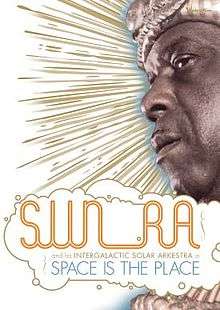Space Is the Place
| Space Is the Place | |
|---|---|
 Region 1 DVD Cover | |
| Directed by | John Coney |
| Produced by | Jim Newman |
| Written by |
Sun Ra Joshua Smith |
| Starring |
Sun Ra Raymond Johnson Seth Hill (uncredited) |
| Music by | Sun Ra |
| Cinematography | Seth Hill |
| Edited by | Barbara Pokras |
Release dates | November 1974 |
Running time | 85 min. |
| Country | United States |
| Language | English |
Space Is the Place is an 85-minute Afrofuturist[1] science fiction film made in 1972 and released in 1974.[2][3] It was directed by John Coney, written by Sun Ra and Joshua Smith, and features Sun Ra and his Arkestra. A soundtrack was released on Evidence Records.
Background
During the late-1960s and early-1970s, Sun Ra and his ensemble made several forays to California. In 1971, Sun Ra taught a course, "The Black Man in the Cosmos," at University of California, Berkeley.[4] Over the course of these California visits, Sun Ra came to the attention of Jim Newman, who produced the film Space Is the Place starring Sun Ra and his Arkestra, and based, in part, on Sun Ra's Berkeley lectures.[4]
Plot
Sun Ra, who has been reported lost since his European tour in June 1969, lands on a new planet in outerspace with his crew "The Arkestra" and decides to settle African Americans on this planet. The medium of transportation he had chosen is music. He travels back in time and returns to the Chicago strip club where he used to play piano with the name "Sonny Ray" in 1943. There he confronts The Overseer (Ray Johnson), a pimp-overlord, and they agree on a duel at cards for the fate of the Black race. Each card drawn is a minor goal to achieve for Ra or The Overseer which will determine the winner of the duel. Then, to present time, Ra disembarks from his spaceship at Oakland and tries to spread his word by meeting with young Blacks at an Oakland youth centre and opening an "employment agency" to recruit people eager to move to the planet. He also agrees with Jimmy Fey (Christopher Brooks), the minion of The Overseer, to arrange radio interviews, a record album, and eventually a concert that will help him dictate his message. At the end, Ra takes Fey's "Black parts" with him to the spaceship, leaving him with his White parts. Fey, now acting white, leaves The Overseer who loses the duel. The planet Earth is destroyed after Ra's spaceship flies into space.
Ra's greatest adversary in his quest is The Overseer, incarnation of evil in the Black community who poses himself to be a community leader and a man of charity. But in fact, he is the tool of the power structure. Ra is also pursued by White government agents (presumably from FBI) who attempt to assassinate him. On the other hand, Jimmy Fey is a representative of Black people in the entertainment industry and mass media.
Production and Release
Space is the Place emerged from Dilexi, an "experimental art series" produced by Jim Newman and directed by John Coney. Wishing to build on his forays into filming avant garde music, Newman recruited Coney to film concert footage of Ra and His Arkestra; Coney then hired Seth Hill to act as cinematographer. Filming of Arkestra performance footage was followed shortly by a scant number of loosely scripted dramatic scenes. Hill was then asked to create "a story to tie all the disparate elements together." To this end, Hill enlisted the help of Joshua Smith, a friend from film school whose fascination with "the culture of pimps and whores" would result in the blaxploitation themes underpinning those scenes in the film not involving Sun Ra.[5] According to assistant director Tom Bullock, the "seemingly death-defying existential leaps in logic and continuity" that resulted from the film's fragmented production were resolved in post-production by editor Barbara Pokras.[6]
Two cuts exist of the film. The first, sometimes referred to as "Sun Ra's edit",[7] is abridged to 64 minutes; for decades following its limited initial release, Space is the Place could only be found on VHS in this form. The second, uncut version runs 82 minutes, and was made available for the first time in 2003, when the film was re-released by Plexifilm. Following another lapse out of print, both cuts of Space is the Place were released together for the first time by Harte Recordings in 2015.
Some of the dialogue is sampled in C-Mos' "2 Million Ways" (Axwell Remix) (2006).
The film inspired The Bright Light Social Hour's 2015 album Space Is Still the Place.[8]
See also
References
- ↑ "Sun Ra: A Joyful Noise". BAM.org.
- ↑ official website for "Space is the Place", fictionalized treatment based on Sun Ra's ideas and philosophy, featuring his Arkestra, filmed in 1972 and 1973.
- ↑ Space Is the Place at the Internet Movie Database
- 1 2 Cook, Richard; Brian Morton (2006) [1992]. The Penguin Guide to Jazz Recordings. The Penguin Guide to Jazz (8th ed.). New York: Penguin. p. 1247. ISBN 0-14-102327-9.
- ↑ Space is the Place: 40th Anniversary Edition. San Francisco: Harte Recordings. 2015. pp. 11–16. ISBN 978-0-9861154-0-0.
- ↑ Space is the Place: 40th Anniversary Edition. p. 21.
- ↑ Space is the Place: 40th Anniversary Edition. p. 7.
- ↑ "The Bright Light Social Hour's 'Space Is Still The Place' Lays Out The Foundation For The 'Future South'". Huffington Post. Retrieved 2015-01-23.